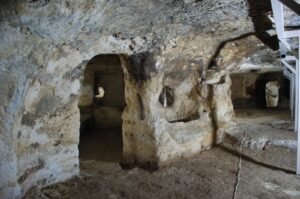Alarge number of artifacts belonging to the second and third centuries A.D. were unearthed in an underground city featuring places of worship, silos, water wells and passages with corridors in southeastern Mardin province’s Midyat district.

Midyat, which is almost an open-air museum with its history and culture, offers a magical atmosphere to its visitors with stone houses, inns, mosques, churches and monasteries that are thousands of years old.
In the district, a cave was found within the scope of a project started two years ago for cleaning and conservation of the historical streets and houses. After it was determined that the cave is a passage to different places with corridors, excavation works were launched to unearth the underground city.
During these excavations, sustained with the cooperation of the Ministry of Culture and Tourism, General Directorate of Cultural Heritage and Museums, Mardin Museum and Midyat Municipality, places of worship, silos, water wells and passages with corridors have been unearthed in the underground city, which is called “Matiate.” Experts also found many artifacts dating back to the second and third centuries A.D. in various parts of the city.
Gani Tarkan, director of Mardin Museum and head of excavations at Matiate, said that their work will spread to the whole district. Stating that similar examples of underground cities have been found in Anatolia but that Midyat’s underground city has very different characteristics, Tarkan continued: “Matiate has been used uninterruptedly for 1,900 years. It was first built as a hiding place or escape area. As it is known, Christianity was not an official religion in the second century. Families and groups who accepted Christianity generally took shelter in underground cities to escape the persecution of Rome or formed an underground city. Possibly, the underground city of Midyat was one of the living spaces built for this purpose. It is an area where we estimate that at least 60-70,000 people lived underground.”
It is expected that the number of visitors to the district will significantly increase with the complete unearthing of the underground city.


